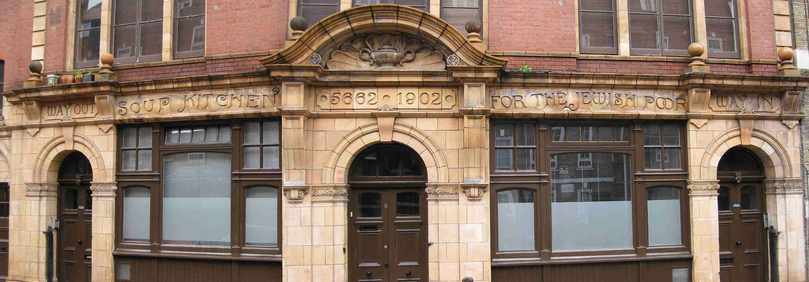As I’ve said before, I don’t know East London well (shame on me!) but because I’m spending a few weeks in this part of the capital, I’ve been taking the opportunity to get to know its mean streets a bit better. Staying in Shoreditch (sandwiched between Old Street, Spitafields and Brick Lane), I’m tripping over history everywhere I walk.
But I know next to nothing about the area’s history, save for the fact that it was once home to a thriving Jewish community.
It’s time to discover more.
Where does the name Shoreditch come from?
I read that the neighbourhood gained its name because of a dyke that ran across the area's marshland - originally it was known as Soersditch, or Sewer's Ditch. There’s also a story that Shoreditch received its name from Jane Shore, the lovely mistress of Edward IV. Unfortunately, she met a rather wretched end - hunger and poverty were her lot and she finally died in a ditch in this dubious part of town. (A sobering tale, and one which I’ll try and remember when I’m feeling sorry for myself!)
Photo courtesy of the Estate Office, Shoreditch
Historically, the area really took off in the 16th century, when the Theatre and the Curtain both opened, and houses began lining the streets north of Bishopsgate. Shoreditch ran as far out as Hoxton (then a village) but because of its location was one of the first ‘outer districts’ to link up with the City. By 1750, it was a parish of around 10,000 people, 15 poor houses and a church named St. Leonards.
How the East End Became Popular with Jewish Immigrants
The area became significantly more crowded in the coming years, because of industry, and a boom in the furniture and rag trades and this is how Shoreditch (and the areas close by - including Brick Lane and Spitalfields) became so popular with Jewish immigrants, Having arrived in England with few resources, or even penniless, they moved in droves to the area, taking on low-paid jobs in cabinet-making, tailoring and labouring at the docks.
As a result, they needed a place to pray, which accounts for the construction of the Sandys Row synagogue (still active today). It developed into a large congregation - one of the biggest in the area - and it was also in this neck of the woods that the original Jewish Free School (now based in Camden) was established, with the aim of helping young kids receive an education in the hopes of ‘bettering themselves.’
From Shoreditch and Brick Lane to Stepney and Bethnal Green
Actually, whilst Shoreditch and Brick Lane were home to a sizeable Jewish community, the Jews actually spread much further afield - down to Cable Street (where the famous battle against fascists took place in the 1930s), over to Mile End and Stepney and also to Bethnal Green and the City of London itself.
Photo courtesy of the Jewish Museum, London
Today, there are few Jews left in this area.
As they became more successful economically (and assimilated more into British society) they moved out of the poverty-stricken East End and to north London’s more green and leafy suburbs.
Now, if you want to buy challah bread or kosher meat, it’s to Golders Green Edgware or Bushey you’ll journey.
But they once dominated the area - by the mid 19th century there were about 46,000 Jews in the capital and by the early 1900’s almost 135,000 (who predominantly lived in the East End).
Whilst the community is more-or-less gone from this area today, if you walk the streets here today, and keep your eyes peeled, you will see signs of a former Jewish presence…indeed, a fascinating one!
Russian Vapour Baths
These baths in Brick Lane were known by their users as ‘Schewiks’ (the name of their owner was Benjamin Schewik). A huge part of communal life, they were used predominantly by men and particularly on Fridays, before synagogue prayers commenced at dusk. Here’s a picture of their sign, stating: “Keep Fit and Well by Regular Visitors to the Real Russian Vapour Baths: Best Massage in London.”
Sandys Row Synagogue
The oldest Askenazi synagogue in London (and the last remaining one in Spitalfields) Sandys Row was established by Duch Jews in the mid 19th century. Formerly a French chapel, for a long time it was the secretariat of the Whitechapel Street Traders’ Association (both from Whitechapel and Petticoat Lane markets).
As late as the 1960’s, the synagogue was still active but by the 1970’s fell into a steep decline and 20 years later it came close to closing down entirely.
However, thanks to a lot of dedicated people, membership is slowly on the rise again and the synagogue has lunchtime prayers (‘mincha’) from Monday to Thursday, for Jewsd who work in the City of London, and also holds fortnightly shabbat services too.
I’ve called up to check times and actually planning on attending services one Friday evening.
The former Jewish Soup Kitchen on Brune Street
The initial Jewish Soup Kitchen was founded in January 1854, on Fashion Street, to distribute bread, soup and meat to impoverished Jews who had fled Russian pogroms and arrived destitute in London. Those who ran it assumed it would be a ‘stop gap’ measure but this, sadly, was not the case and the recipients, soon became sick and elderly people in the community.
Photo courtesy of British Jews in the First World War
It moved premises in 1902, to Butler Street (which changed its name to Brune Street around 30 years later) and today there’s no evidence of the good works it did (at its height, feeding 5,000 people each week) save for the words ‘Soup kitchen for the Jewish Poor” carved into the stone above the door.
And I haven’t even found Bevis Marks synagogue yet. No doubt that deserves another blog post all of itself…





